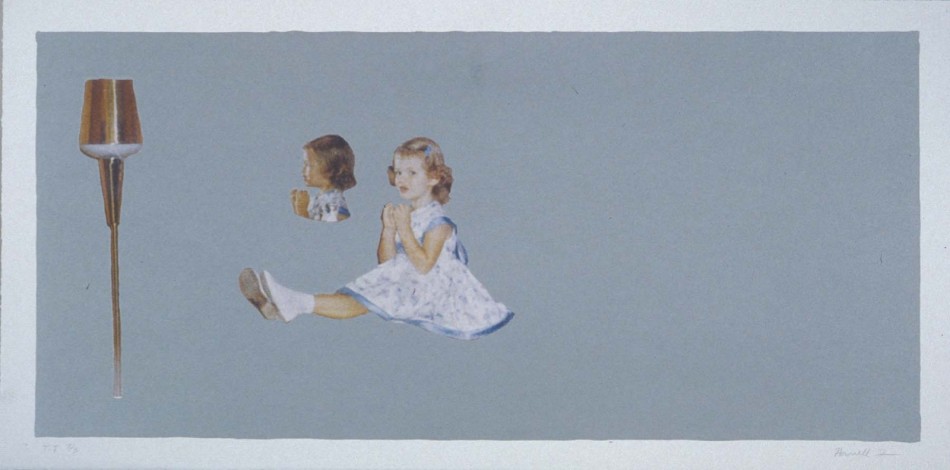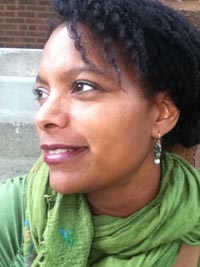
Harrell Fletcher, Holiday, 2002
A Feminist Print Show at Tamarind; A New Fine Arts Dean for UNM
I first encountered Sue Coe’s lithograph, The Unspeakable Pursuing the Uneatable (1996), near to the date when it was printed at Tamarind Institute in Albuquerque, in 1997. At that time I wrote a biweekly art criticism column for Albuquerque Journal North that ran 1000 words in the Thursday edition. Coe’s lithograph, created a dense field of black both very long and very deep. It constellated hunters encircling a small band of visibly threatened game. In Sue Coe’s world, the bear, the parrot, the prey — were encircled by guns. No Exit. Their vulnerability was code for a Mab Libs entry. Seeking an adjective, the phrase: endangered (blank) rights could be filled in by you-pick-it. Sue Coe spoke to me on the spot. I fell for Tamarind printmaking the way I first fell for the spell of the monk in his study in Albrecht Durer, or the very fine ears of his rabbit.
I was thrilled to see this Sue Coe print represented in Good in the Kitchen, the exhibit now at Tamarind Institute (through March 13). Curator John Mulvany (25-year chair of Columbia College’s departments of Art, Design and Photography) was mindful to select prints representing 30 years of printmaking at Tamarind. He found himself selecting prints and then discerning half of their makers were men. That led to the pertinent question: whether the women’s movement had been responsible for making domesticity available as a subject to male artists? Did feminism narrow the gender gap? Are gender relations blase, full of futility, or other?
 When I look at a print of colored buttons (1996) by Donald Sultan, I at first perceive them as quite dissimilar to his flower petals which lavishly occupy their framed environment as paintings. The buttons are more prim. A glance caused me to riff on old-style subway tokens (with the Y) lying flat in a jade tray on my father’s bureau drawer.
When I look at a print of colored buttons (1996) by Donald Sultan, I at first perceive them as quite dissimilar to his flower petals which lavishly occupy their framed environment as paintings. The buttons are more prim. A glance caused me to riff on old-style subway tokens (with the Y) lying flat in a jade tray on my father’s bureau drawer.
If work to be done is one theme, work undone expresses through Mark Licari’s Mr. Clean (2006), in which a tortuous vacuum cleaner belches flames and smoke from its bag and its belt. The picture conveys it’s not only frayed wire (frayed nerves) symbolized by the tidy machine exploding, it’s a plethora of hair that has gummed up the appliance. Commentary on male-female relations? The relation of raw to effectively cooked.

Sue Coe, The Unspeakable Pursing the Uneatable, 1997
Among the women (and my favorite is probably Alison Saar, unshown here, but see the virtual exhibition), Sue Coe’s The Unspeakable Pursuing the Uneatable, put me squarely into embodied memory, as noted, of my seven years in the ’90s reviewing contemporary art shows for the Albuquerque Journal North. I still find it to be an absolute show-stopper. It’s as pertinent as it ever was; an amalgamation of machismo; the only observed “right” the right to bear arms.
In aggregate, it’s meaning that’s at stake in this 30-year lithography review. (Tamarind has had since last summer, a new gallery director who moved down from Santa Fe, Meghan Ferguson, working under Marjorie Devon.)

Kymberly Pinder
That brings me to UNM’s new Fine Arts Dean, Kymberly Pinder, who got here in August and professed — to a room full of women at a cocktail gathering last week — that her children love Albuquerque, and so does she. (They hail from Chicago, where Pinder had taught at School of Art Institute of Chicago.) Pinder contributed a catalog essay to the recent new catalog of the Guerrilla Girls, Not Ready to Make Nice. Bearing in mind the art world really is an exquisitely small world, the Guerrilla Girls were in residency at Columbia College A+D last spring (see above-mentioned John Mulvany). So was Bad at Sports, the contemporary art talk podcast, which published a review of Not Ready in which the author noted that shows at Museum of Contemporary Art (Chicago) since 2010 had been 80 percent male. “When I read that, I thought, Wow, that’s way more than I expected. Then my heart sank a little.” (The writer wrote.)
You can see the full article here. It did, I must admit, make me take a pause regarding the emphasis on the issue of equality toward men making prints about life in the domestic sphere, when it comes to the Tamarind show here reviewed. This show, however, is very worth seeing; and the new programs that UNM may offer under Dean Pinder, with scholarship in street art and culture jamming under her belt, worth watching.
